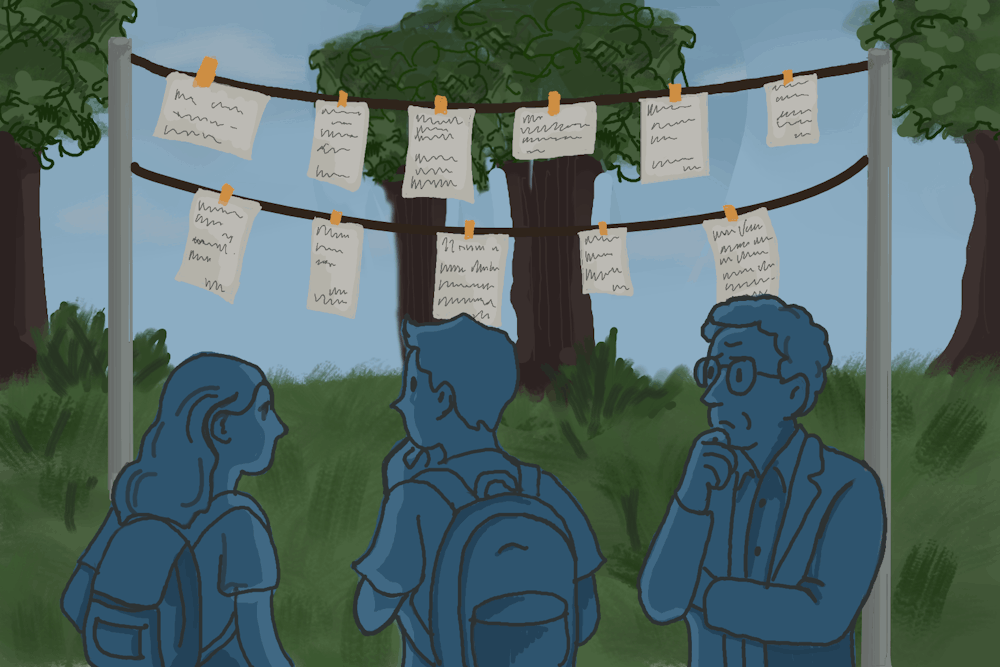Pinned to a clothesline on South Lawn, sheets of paper fluttered like silent confessions in the wind. Scrawled by members of the University community, each piece of paper contained a struggle, a confession, a reflection or a word of advice.
These stories are the lifeblood of the Strangers Project, a nationwide initiative that aims to foster connection among strangers through anonymous storytelling. The Strangers Project was spearheaded at the University by Flash, an organization that hosts educational pop-ups to foster intellectual curiosity beyond the classroom. Flash initially brought the project to Grounds April 10 and 14. Due to a rain check, they planned to bring it back Monday, but unforeseen circumstances led the club to cancel.
Pioneered in New York City, the Strangers Project began with a mission to celebrate the human experience by collecting and exhibiting anonymous personal stories. Inspired by the original project, Flash has encouraged passersby at the University to write anonymous letters — narratives, pieces of advice, personal anecdotes — which the authors can subsequently put on display for more strangers to read.
According to Michael Lipton, Flash president and third-year Engineering student, the project aims to extend insight and a sense of comfort to everyone involved — and helps people realize that strangers are human, too.
“The whole point is, whenever you read [a letter], you're no longer supposed to be a stranger with [the] person who wrote that letter,” Lipton said.
Lipton said that some of the letters are more lighthearted, mentioning common struggles with roommates, impostor syndrome and grades. Others delve into deeper, more emotional territory, from love to heartbreak and loss. Together, the letters create a tapestry of the human experience — the good, the bad and the ugly.
“Every single person who passes you by has a story to tell. Some of those stories might just be a drawing, but it may be a beautiful idea that I could have never even imagined myself or thought that I would ever hear,” Lipton said. “That type of interaction has been so amazing.”
Cate Murcko, Flash Secretary and second-year College student, said that reading these letters has given her a greater appreciation for the humanity of others. She said that each letter reveals that there is a real person, with a wealth of lived experience, behind every unfamiliar face.
“It's giving me a greater perspective of the lives of others,” Murcko said. “I see everyone a little bit more for what they've been through, regardless of whether I know what that is or not.”
In walking through the Strangers Project exhibition, Murcko said that she was surprised at how many of the letters resonated with her. She said that she thinks when people have the space to be vulnerable, it becomes clear that they have far more in common with one another than they think.
“I didn't expect to see so much that I related to — sentiments that I have felt before,” Murcko said. “But when people take the time to pour their hearts out because they feel comfortable — [because] no one's going to associate their name with it — you get some sentiments that I feel like a lot of us share.”
Echoing this sentiment, Shreya Malani, Strangers Project manager and fourth-year Engineering student, noted how important a project like this is in this digital age, where students fear the repercussions of the permanence of their words online. Since it is done on pencil and paper, the Strangers Project offers a respite, allowing participants to be completely honest with themselves and others. Malani said that participants share vulnerable stories that they might not otherwise tell.
Speaking from her experience administering the project, Murcko explains that participants seem to have appreciated the opportunity to express themselves through writing — sharing their thoughts in a way that has zero repercussions.
“When people walk away after writing their letters, they always have a smile on their face,” Murcko said. “Even if we hang up the letter [and it’s] the most devastating piece of writing you've ever read, it feels good, I think, [for them] to share.”
Lipton echoed Murcko’s sentiment, saying that Flash has received many positive comments about the Strangers Project from people that have walked through the exhibition.
“We had parents and random students come [up] afterwards and be like, ‘Wow, this is incredible. This meant a lot to me.’ I had someone [tell] me that this made their week,” Lipton said. “Moments like that just reaffirmed that what we were doing is cool and good and valuable.”
Whether passersby decide to contribute to the project with a letter or simply walk through the exhibition, Murcko said the Strangers Project allows participants to reflect on themselves, and gain a new perspective, through the words of others. In this way, she said, people develop awareness of the interconnectedness of the human experience.
“I feel like there's something to seeing yourself through someone else,” Murcko said. “That's the connection that we're looking to create with the Strangers Project.”







